Drought Dynamics and Vegetation Productivity in Different Land Management Systems of Eastern Cape, South Africa—A Remote Sensing Perspective
Abstract
:1. Introduction
2. Materials and Methods
2.1. Study Area
2.2. Data and Methods
2.2.1. Enhanced Vegetation Index (EVI)
2.2.2. Time Series Trend Analysis
2.2.3. Calculation of Vegetation Condition Index (VCI) for Drought Classification
2.2.4. Precipitation Data
2.2.5. Precipitation–Vegetation Correlation Analysis
2.2.6. Land Cover Information
3. Results
3.1. Vegetation Productivity Trends
3.2. VCI Development in Eastern Cape during Normal Conditions versus Drought Conditions
3.3. Precipitation and Vegetation—How Close Is the Link?
4. Discussion
5. Conclusions
Acknowledgments
Author Contributions
Conflicts of Interest
References
- Wilhite, D.A. Chapter 1 Drought as a Natural Hazard: Concepts and Definitions. In Drought: A Global Assessment; Wilhite, D.A., Ed.; Routledge: London, UK, 2000; pp. 3–18. [Google Scholar]
- Toulmin, C. Drought and the farming sector: Loss of farm animals and post-drought rehabilitation. Dev. Policy Rev. 1987, 5, 125–148. [Google Scholar] [CrossRef]
- Sivakumar, M.V.K. Agricultural Drought—WMO Perspectives. In Agricultural Drought Indices, Proceedings of the Expert Meeting, Murcia, Spain, 2–4 June 2010; Sivakumar, M.V.K., Motha, R.P., Wilhite, D.A., Wood, D.A., Eds.; World Meteorological Organization: Geneva, Switzerland, 2011; pp. 22–34. [Google Scholar]
- Pachauri, R.K.; Allen, M.R.; Barros, V.R.; Broome, J.; Cramer, W.; Christ, R.; Church, J.A.; Clarke, L.; Dahe, Q.; Dasgupta, P.; et al. Climate Change 2014: Synthesis Report; Contribution of Working Groups I, II and III to the Fifth Assessment Report of the Intergovernmental Panel on Climate Change; Pachauri, R.K., Meyer, L., Eds.; IPCC: Geneva, Switzerland, 2014. [Google Scholar]
- Henricksen, B.L.; Durkin, J.W. Growing period and drought early warning in Africa using satellite data. Int. J. Remote Sens. 1986, 7, 1583–1608. [Google Scholar] [CrossRef]
- Rojas, O.; Vrieling, A.; Rembold, F. Assessing drought probability for agricultural areas in Africa with coarse resolution remote sensing imagery. Remote Sens. Environ. 2011, 115, 343–352. [Google Scholar] [CrossRef]
- Moacelli, G. WMO Drought Assessment and Forecasting. Weather, Climate and Water; Draft Report 2005, WGH/RA VI/Doc.8 (26.IV.2005); World Meteorological Organization: Pruhonice, Czec Republic, 2005; Available online: www.wmo.int/pages/prog/hwrp/documents/regions/DOC8-pdf (accessed on 27 July 2017).
- Wilhite, D.A.; Glantz, M.H. Understanding the drought phenomenon: The role of definitions. Water Int. 1985, 10, 111–120. [Google Scholar] [CrossRef]
- Keyantash, J.; Dracup, J.A. The quantification of drought: An evaluation of drought indices. Bull. Am. Meteorol. Soc. 2002, 83, 1167–1180. [Google Scholar]
- McKee, T.B.; Doesken, N.J.; Kleist, J. The Relationship of Drought Frequency and Duration to Time Scales. In Proceedings of the 8th Conference on Applied Climatology, Anaheim, CA, USA, 17–22 January 1993. [Google Scholar]
- McKee, T.B.; Doesken, N.J.; Kleist, J. Drought Monitoring with Multiple Time Scales. In Proceedings of the 9th Conference on Applied Climatology, Dallas, TX, USA, 15–20 January 1995; pp. 233–236. [Google Scholar]
- World Meteorological Organization (WMO). Standardized Precipitation Index User Guide; WMO: Geneva, Switzerland, 2012. [Google Scholar]
- Hayes, M.J.; Svoboda, M.D.; Wilhite, D.A.; Vanyarkho, O.V. Monitoring the 1996 drought using the standardized precipitation index. Bull. Am. Meteorol. Soc. 1999, 80, 429–438. [Google Scholar] [CrossRef]
- Rhee, J.; Im, J.; Carbone, G.J. Monitoring agricultural drought for arid and humid regions using multi-sensor remote sensing data. Remote Sens. Environ. 2010, 114, 2875–2887. [Google Scholar] [CrossRef]
- Son, N.T.; Chen, C.F.; Chen, C.R.; Chang, L.Y.; Minh, V.Q. Monitoring agricultural drought in the Lower Mekong Basin using MODIS NDVI and land surface temperature data. Int. J. Appl. Earth Obs. 2012, 18, 417–427. [Google Scholar] [CrossRef]
- Vicente-Serrano, S.M.; Beguería, S.; Gimeno, L.; Eklundh, L.; Giuliani, G.; Weston, D.; El Kenawy, A.; López-Moreno, J.I.; Nieto, R.; Ayenew, T.; et al. Challenges for drought mitigation in Africa: The potential use of geospatial data and drought information systems. Appl. Geogr. 2012, 34, 471–486. [Google Scholar] [CrossRef] [Green Version]
- Skakun, S.; Kussul, N.; Kussul, O.; Shelestov, A. Quantitative estimation of drought risk in Ukraine using satellite data. In Proceedings of the IEEE Geoscience and Remote Sensing Symposium, Quebec, QC, Canada, 13–18 July 2014; pp. 5091–5094. [Google Scholar]
- World Meteorological Organization (WMO); Global Water Partnership (GWP). Handbook of Drought Indicators and Indices; Svoboda, M., Fuchs, B.Z., Eds.; Integrated Drought Management Tools and Guidelines SERIES 2; Integrated Drought Management Programme (IDMP): Geneva, Switzerland, 2016; Available online: www.droughtmanagement.info/literature/GWP_Handbook_of_Drought_Indicators_and_Indices_2016.pdf (accessed on 27 July 2017).
- Unganai, L.S.; Kogan, F.N. Drought monitoring and corn yield estimation in Southern Africa from AVHRR data. Remote Sens. Environ. 1998, 63, 219–232. [Google Scholar] [CrossRef]
- Quiring, S.M.; Ganesh, S. Evaluating the utility of the vegetation condition index (VCI) for monitoring meteorological drought in Texas. Agric. For. Meteorol. 2010, 150, 330–339. [Google Scholar] [CrossRef]
- Kogan, F.N. Remote sensing of weather impacts on vegetation in non-homogeneous areas. Int. J. Remote Sens. 1990, 11, 1405–1419. [Google Scholar] [CrossRef]
- Rouault, M.; Richard, Y. Intensity and spatial extension of drought in South Africa at different time scales. Water SA 2003, 29, 489–500. [Google Scholar] [CrossRef]
- Holzman, M.E.; Rivas, R.E. Early Maize Yield Forecasting From Remotely Sensed Temperature/Vegetation Index Measurements. IEEE J. Sel. Top. Appl. Earth Obs. Remote Sens. 2016, 9, 507–519. [Google Scholar] [CrossRef]
- Gu, Y.; Brown, J.F.; Verdin, J.P.; Wardlow, B. A five-year analysis of MODIS NDVI and NDWI for grassland drought assessment over the Central Great Plains of the United States. Geophys. Res. Lett. 2007, 34. [Google Scholar] [CrossRef]
- Zribi, M.; Dridi, G.; Amri, R.; Lili-Chabaane, Z. Analysis of the effect of drought on vegetation cover in a Mediterranean Region through the use of SPOT-VGT and TERRA-MODIS long time series. Remote Sens. 2016, 8, 992. [Google Scholar] [CrossRef]
- Parplies, A.; Dubovyk, O.; Tewes, A.; Mund, J.-P.; Schellberg, J. Phenomapping of rangelands in South Africa using time series of RapidEye data. Int. J. Appl. Earth Obs. 2016, 53, 90–102. [Google Scholar] [CrossRef]
- Oomen, B. Chiefs in South Africa: Law, Power & Culture in the Post-Apartheid Era; James Currey: Melton, UK, 2005. [Google Scholar]
- Hoffman, M.T.; Todd, S. A national review of land degradation in South Africa: The influence of biophysical and socio-economic factors. J. South. Afr. Stud. 2000, 26, 743–758. [Google Scholar] [CrossRef]
- Dubovyk, O.; Landmann, T.; Erasmus, B.F.N.; Tewes, A.; Schellberg, J. Monitoring vegetation dynamics with medium resolution Modis-Evi time series at Sub-Regional Scale in Southern Africa. Int. J. Appl. Earth Obs. 2015, 38, 175–183. [Google Scholar] [CrossRef]
- Ngaka, M.J. Drought preparedness, impact and response: A case of the Eastern Cape and Free State provinces of South Africa. Jamba J. Disaster Risk Stud. 2012, 4, 1–10. [Google Scholar] [CrossRef]
- Conacher, A.J.; Sala, M. (Eds.) Land Degradation in Mediterranean Environments of the World: Nature and Extent, Causes and Solutions; John Wiley and Sons Ltd: Hoboken, NJ, USA, 1998. [Google Scholar]
- Holden, S.; Shiferaw, B. Land degradation, drought and food security in a less-favoured area in the Ethiopian Highlands: A bio-economic model with market imperfections. Agric. Econ. 2004, 30, 31–49. [Google Scholar] [CrossRef]
- Dregne, H.E. Land degradation in the drylands. Arid Land Res. Manag. 2002, 16, 99–132. [Google Scholar] [CrossRef]
- Ravi, S.; Breshears, D.D.; Huxman, T.E.; D’Odorico, P. Land degradation in drylands: Interactions among hydrologic–aeolian erosion and vegetation dynamics. Geomorphology 2010, 116, 236–245. [Google Scholar] [CrossRef]
- Blaikie, P.; Brookfield, H. Land Degradation and Society; Routledge: New York, NY, USA, 2015. [Google Scholar]
- Sonneveld, B.; Keyzer, M.A.; Ndiaye, D. Quantifying the impact of land degradation on crop production: The case of Senegal. Solid Earth 2015, 7, 93–103. [Google Scholar] [CrossRef]
- Hoare, D.B.; Bredenkamp, G.J. Grassland communities of the Amatola/Winterberg Mountain Region of the Eastern Cape, South Africa. S. Afr. J. Bot. 1999, 65, 75–82. [Google Scholar] [CrossRef]
- Hoare, D.B.; Bredenkamp, G.J. Syntaxonomy and environmental gradients of the grasslands of the Stormberg/Drakensberg Mountain Region of the Eastern Cape, South Africa. S. Afr. J. Bot. 2001, 67, 595–608. [Google Scholar] [CrossRef]
- Kane, R.P. Periodicities, ENSO effects and trends of some South African rainfall series: An update. S. Afr. J. Sci. 2009, 105. [Google Scholar] [CrossRef]
- Malherbe, J.; Dieppois, B.; Maluleke, P.; Staden, M.V.; Pillay, D.L. South African droughts and decadal variability. Nat. Hazards 2016, 80, 657–681. [Google Scholar] [CrossRef]
- South African Weather Service (SAWS). Available online: http://www.weathersa.co.za/ (accessed on 27 July 2017).
- Food and Agriculture Organization of the United Nations (FAO). El Niño Set to Have a Devastating Impact on Southern Africa’s Harvests and Food Security 2016. Available online: http://www.fao.org/news/story/en/item/382932/icode/ (accessed on 27 July 2017).
- Goldblatt, A. Agriculture: Facts & Trends. 2004. Available online: http://awsassets.wwf.org.za/downloads/facts_brochure_mockup_04_b.pdf (accessed on 27 July 2017).
- Statistics South Africa (StatSA) Census 2011. Available online: http://www.statssa.gov.za (accessed on 15 August 2017).
- DAFF Maps and Graphics: Environmental Geographic Information Systems (EGIS) 2016. Available online: https://egis.environment.gov.za (accessed on 27 July 2017).
- Stats SA Library Cataloguing-in-Publication (CIP). Data Census 2011 Provincial Profile: Eastern Cape; Statistics South Africa: Pretoria, South Africa, 2014; Appendix pp. 46–49.
- Ntsebeza, L.; Hall, R. The Land Question in South Africa: The Challenge of Transformation and Redistribution; HSRC Press: Pretoria, South Africa, 2007. [Google Scholar]
- Helldén, U.; Tottrup, C. Regional desertification: A global synthesis. Glob. Planet. Chang. 2008, 64, 169–176. [Google Scholar] [CrossRef]
- Nkonya, E. The Economics of Land Degradation: Toward an Integrated Global Assessment; Peter Lang: Frankfurt, Germany, 2011. [Google Scholar]
- De Jong, R.; de Bruin, S.; Schaepman, M.; Dent, D. Quantitative mapping of global land degradation using earth observations. Int. J. Remote Sens. 2011, 32, 6823–6853. [Google Scholar] [CrossRef] [Green Version]
- Huete, A.; Didan, K.; Miura, T.; Rodriguez, E.P.; Gao, X.; Ferreira, L.G. Overview of the radiometric and biophysical performance of the MODIS vegetation indices. Remote Sens. Environ. 2002, 83, 195–213. [Google Scholar] [CrossRef]
- Pettorelli, N. Normalized Difference Vegetation Index; Oxford University Press: Oxford, UK, 2013. [Google Scholar]
- Jiang, Z.; Huete, A.R.; Didan, K.; Miura, T. Development of a two-band enhanced vegetation index without a blue band. Remote Sens. Environ. 2008, 112, 3833–3845. [Google Scholar] [CrossRef]
- Vermote, E.F.; El Saleous, N.Z.; Justice, C.O. Atmospheric correction of modis data in the visible to middle infrared: First results. Remote Sens. Environ. 2002, 83, 97–111. [Google Scholar] [CrossRef]
- NASA EOSDIS Land Processes DAAC MODIS Reprojection Tool. Available online: https://lpdaac.usgs.gov/tools/modis_reprojection_tool (accessed on 21 March 2017).
- Reynolds, J.F.; Smith, D.M.S.; Lambin, E.F.; Turner, B.L.; Mortimore, M.; Batterbury, S.P.J.; Downing, T.E.; Dowlatabadi, H.; Fernández, R.J.; Herrick, J.E.; et al. Global desertification: Building a science for dryland development. Science 2007, 316, 847–851. [Google Scholar] [CrossRef] [PubMed]
- Symeonakis, E.; Drake, N. Monitoring desertification and land degradation over Sub-Saharan Africa. Int. J. Remote Sens. 2004, 25, 573–592. [Google Scholar] [CrossRef]
- Bai, Z.G.; Dent, D.L.; Olsson, L.; Schaepman, M.E. Proxy global assessment of land degradation. Soil Use Manag. 2008, 24, 223–234. [Google Scholar] [CrossRef]
- Kendall, M.G. A new measure of rank correlation. Biometrika 1938, 30, 81–93. [Google Scholar] [CrossRef]
- Mann, H.B. Nonparametric tests against trend. Econometrica 1945, 13, 245–259. [Google Scholar] [CrossRef]
- Neeti, N.; Eastman, J.R. A contextual Mann-Kendall approach for the assessment of trend significance in image time series. Trans. GIS 2011, 15, 599–611. [Google Scholar] [CrossRef]
- Tüshaus, J.; Dubovyk, O.; Khamzina, A.; Menz, G. Comparison of medium spatial resolution ENVISAT-MERIS and Terra-MODIS time series for vegetation decline analysis: a case study in Central Asia. Remote Sens. 2014, 6, 5238–5256. [Google Scholar] [CrossRef]
- Kogan, F.N. Application of vegetation index and brightness temperature for drought detection. Adv. Space Res. 1995, 15, 91–100. [Google Scholar] [CrossRef]
- Bhuiyan, C.; Singh, R.P.; Kogan, F.N. Monitoring drought dynamics in the Aravalli Region (India) using different indices based on ground and remote sensing data. Int. J. Appl. Earth Obs. 2006, 8, 289–302. [Google Scholar] [CrossRef]
- Zhang, A.; Jia, G. Monitoring meteorological drought in semiarid regions using multi-sensor microwave remote sensing data. Remote Sens. Environ. 2013, 134, 12–23. [Google Scholar] [CrossRef]
- Zambrano, F.; Lillo-Saavedra, M.; Verbist, K.; Lagos, O. Sixteen years of agricultural drought assessment of the biobío region in Chile using a 250 m resolution vegetation condition index (VCI). Remote Sens. 2016, 8, 530. [Google Scholar] [CrossRef]
- Nicholson, S.E.; Davenport, M.L.; Malo, A.R. A comparison of the vegetation response to rainfall in the Sahel and East Africa, using normalized difference vegetation index from Noaa Avhrr. Clim. Chang. 1990, 17, 209–241. [Google Scholar] [CrossRef]
- Davenport, M.L.; Nicholson, S.E. On the relation between rainfall and the normalized difference vegetation index for diverse vegetation types in East Africa. Int. J. Remote Sens. 1993, 14, 2369–2389. [Google Scholar] [CrossRef]
- Herrmann, S.M.; Anyamba, A.; Tucker, C.J. Recent trends in vegetation dynamics in the African Sahel and their relationship to climate. Glob. Environ. Chang. 2005, 15, 394–404. [Google Scholar] [CrossRef]
- Funk, C.; Peterson, P.; Landsfeld, M.; Pedreros, D.; Verdin, J.; Shukla, S.; Husak, G.; Rowland, J.; Harrison, L.; Hoell, A.; et al. The climate hazards infrared precipitation with stations—A new environmental record for monitoring extremes. Sci. Data 2015, 2, 150066. [Google Scholar] [CrossRef] [PubMed]
- GEOTERRAIMAGE 2013–2014 South African National Land-Cover Dataset. Data User Report and MetaData 2015. Available online: https://www.geoterraimage.com/uploads/GTI%20201314%20SA%20LANDCOVER%20REPORT%20-%20CONTENTS%20vs%2005%20DEA%20OPEN%20ACCESS%20vs2b.pdf (accessed on 27 July 2017).
- Guha-Sapir, D. EM-DAT: The Emergency Events Database. Available online: www.em-dat.be (accessed on 26 July 2017).
- Hardy, M.; Dziba, L.; Kilian, W.; Tolmay, J. Rainfed farming systems in South Africa. In Rainfed Farming Systems; Tow, P., Cooper, I., Partridge, I., Birch, C., Eds.; Springer: Dordrecht, The Netherlands, 2011; pp. 395–432. [Google Scholar]
- Meadows, M.E.; Hoffman, M.T. The nature, extent and causes of land degradation in South Africa: Legacy of the past, lessons for the future? Area 2002, 34, 428–437. [Google Scholar] [CrossRef]
- Ward, D. Do we understand the causes of bush encroachment in African savannas? Afr. J. Range Forage Sci. 2005, 22, 101–105. [Google Scholar] [CrossRef]
- Graw, V.; Oldenburg, C.; Dubovyk, O. Bush Encroachment Mapping for Africa: Multi-Scale Analysis with Remote Sensing and GIS; Social Science Research Network: Rochester, NY, USA, 2016. [Google Scholar]
- Saha, M.V.; Scanlon, T.M.; D’Odorico, P. Examining the linkage between shrub encroachment and recent greening in water-limited Southern Africa. Ecosphere 2015, 6, 1–16. [Google Scholar] [CrossRef]
- Mitchard, E.T.A.; Flintrop, C.M. Woody encroachment and forest degradation in Sub-Saharan Africa’s woodlands and savannas 1982–2006. Philos. Trans. R. Soc. B 2013, 368, 20120406. [Google Scholar] [CrossRef] [PubMed] [Green Version]
- Meissner, H.H.; Scholtz, M.M.; Palmer, A.R. Sustainability of the South African livestock sector towards 2050 Part 1: Worth and impact of the sector. S. Afr. J. Anim. Sci. 2013, 43, 282–297. [Google Scholar] [CrossRef]
- O’Connor, T.G.; Crow, V.R.T. Rate and pattern of bush encroachment in Eastern Cape savanna and grassland. Afr. J. Range Forage Sci. 1999, 16, 26–31. [Google Scholar] [CrossRef]
- Wigley, B.J.; Bond, W.J.; Hoffman, M.T. Bush encroachment under three contrasting land-use practices in a mesic South African savanna. Afr. J. Ecol. 2009, 47, 62–70. [Google Scholar] [CrossRef]
- Skowno, A.L.; Thompson, M.W.; Hiestermann, J.; Ripley, B.; West, A.G.; Bond, W.J. Woodland expansion in South African grassy biomes based on satellite observations (1990–2013): General Patterns and Potential Drivers. Glob. Chang. Biol. 2017, 23, 2358–2369. [Google Scholar] [CrossRef] [PubMed]
- Jordaan, A.J.; Sakulski, D.M.; Muyambo, F.; Shwababa, S.; Mdungela, N.; Phatudi-Mphahlele, B.; Mashimbye, C.; Mlambo, D.; Fadeyi, O.; Miya, T.; et al. Vulnerability, Adaptation to and Coping with Drought: The Case of Commercial and Subsistence Rain Fed Farming in the Eastern Cape. 2017. Available online: http://dimtecrisk.ufs.ac.za/wrc_ec/report/2_report.pdf (accessed on 19 September 2017).
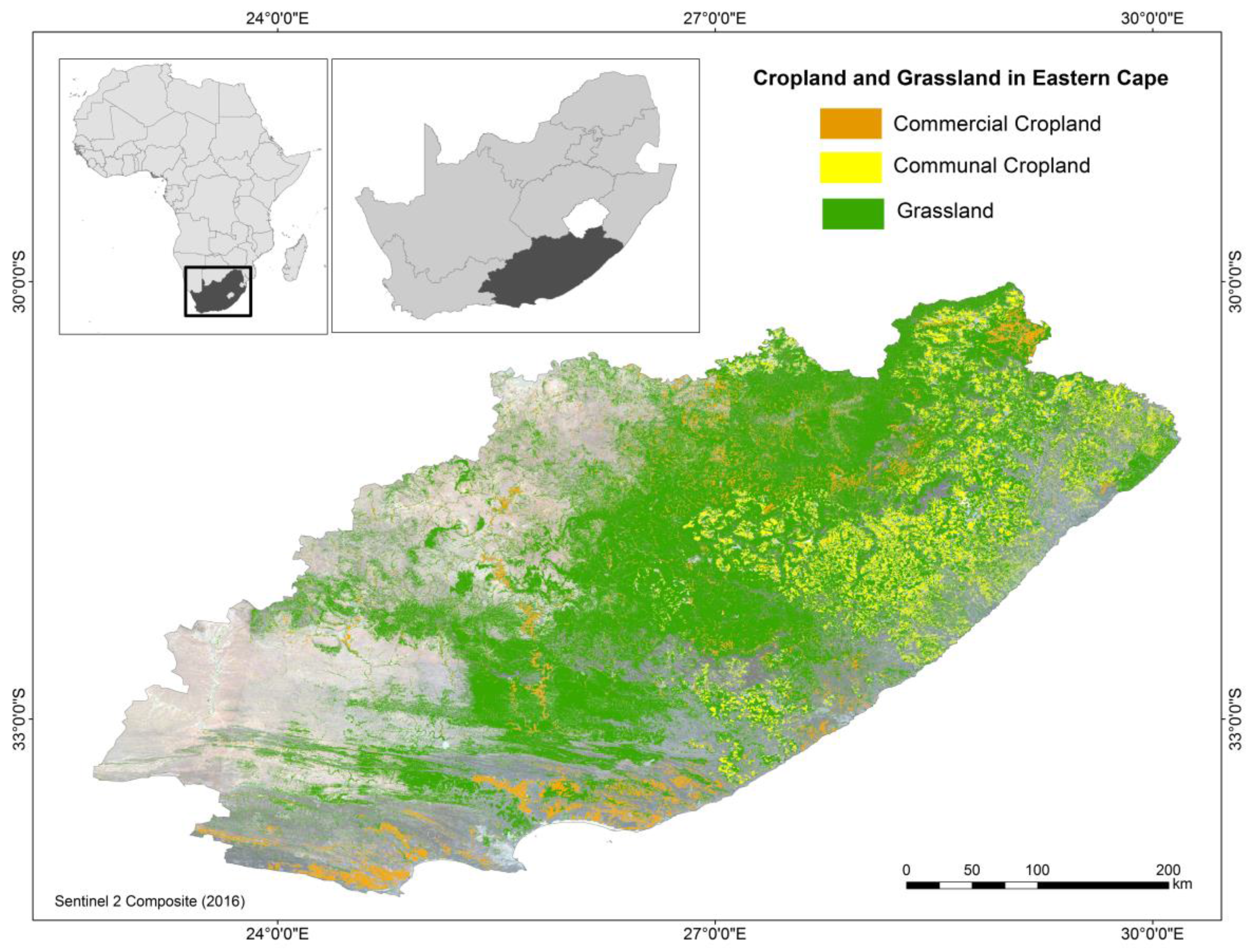
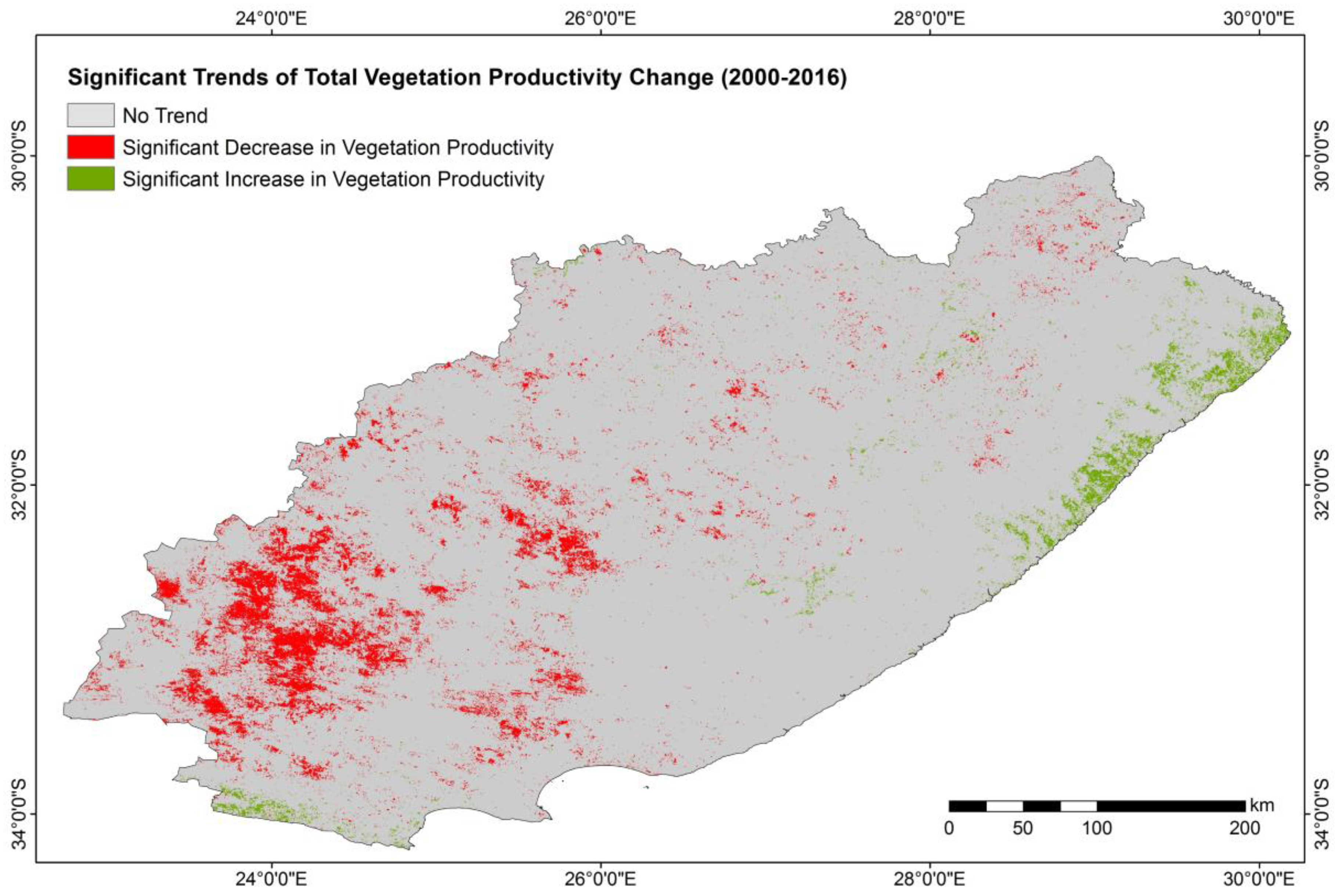
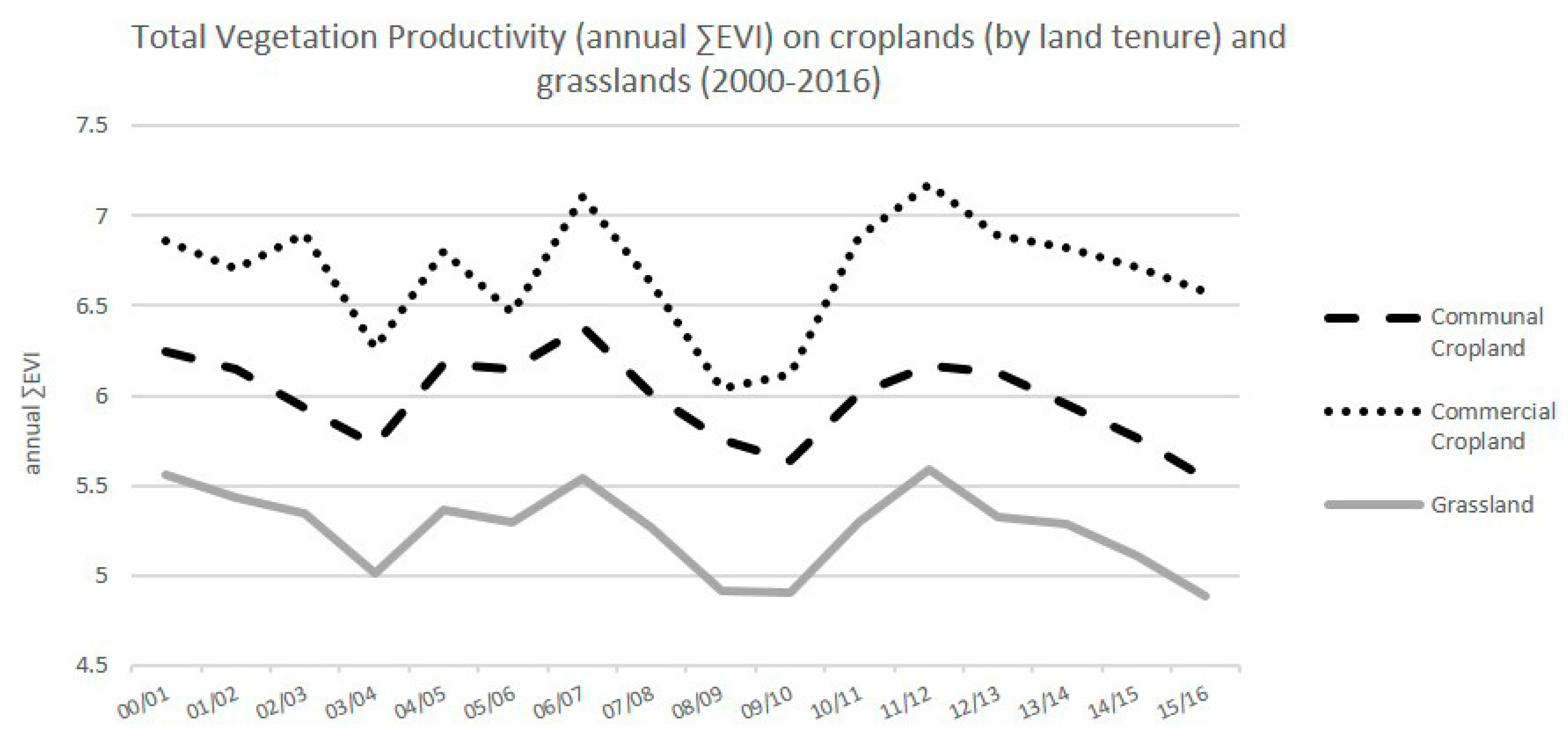
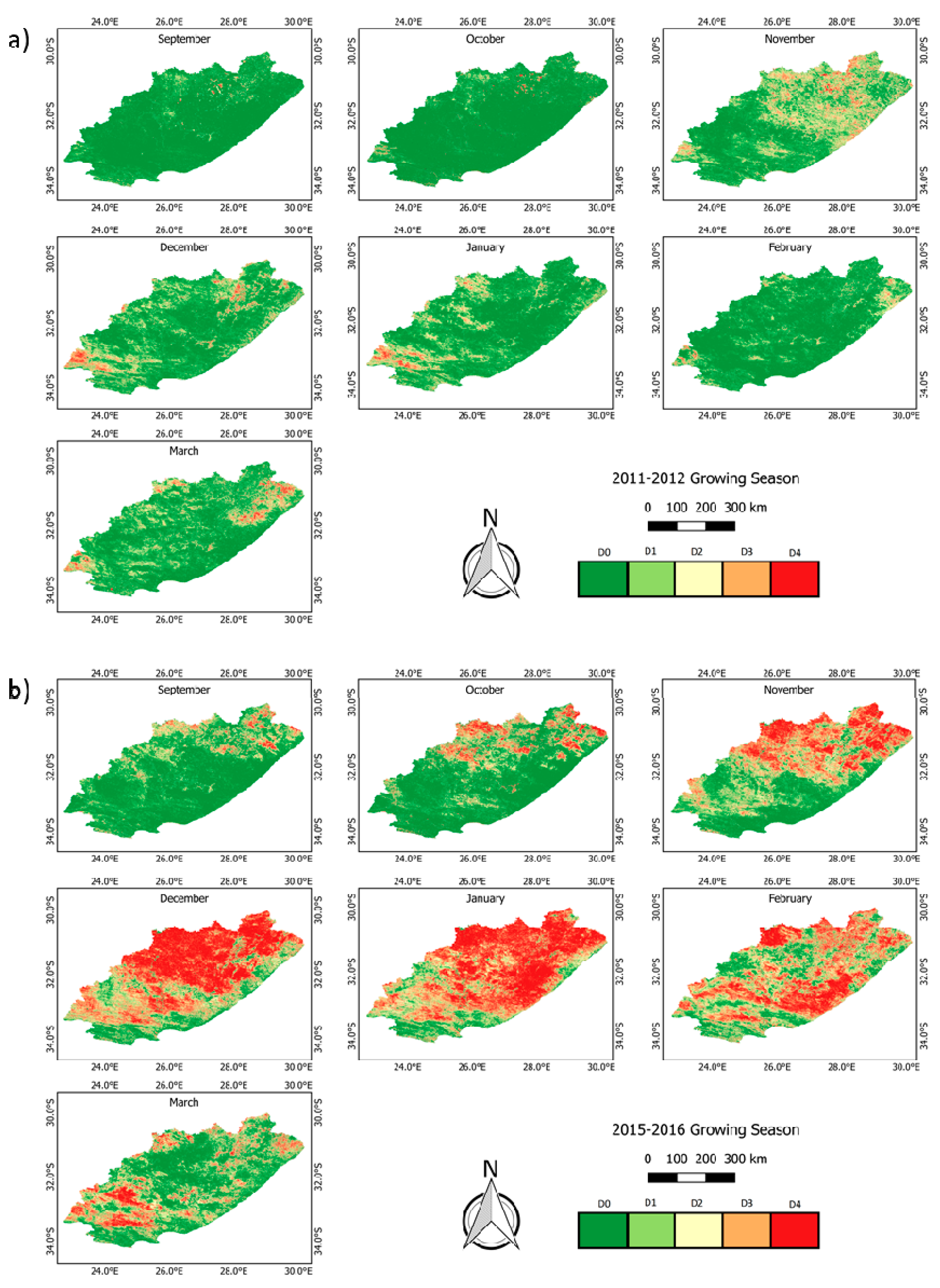
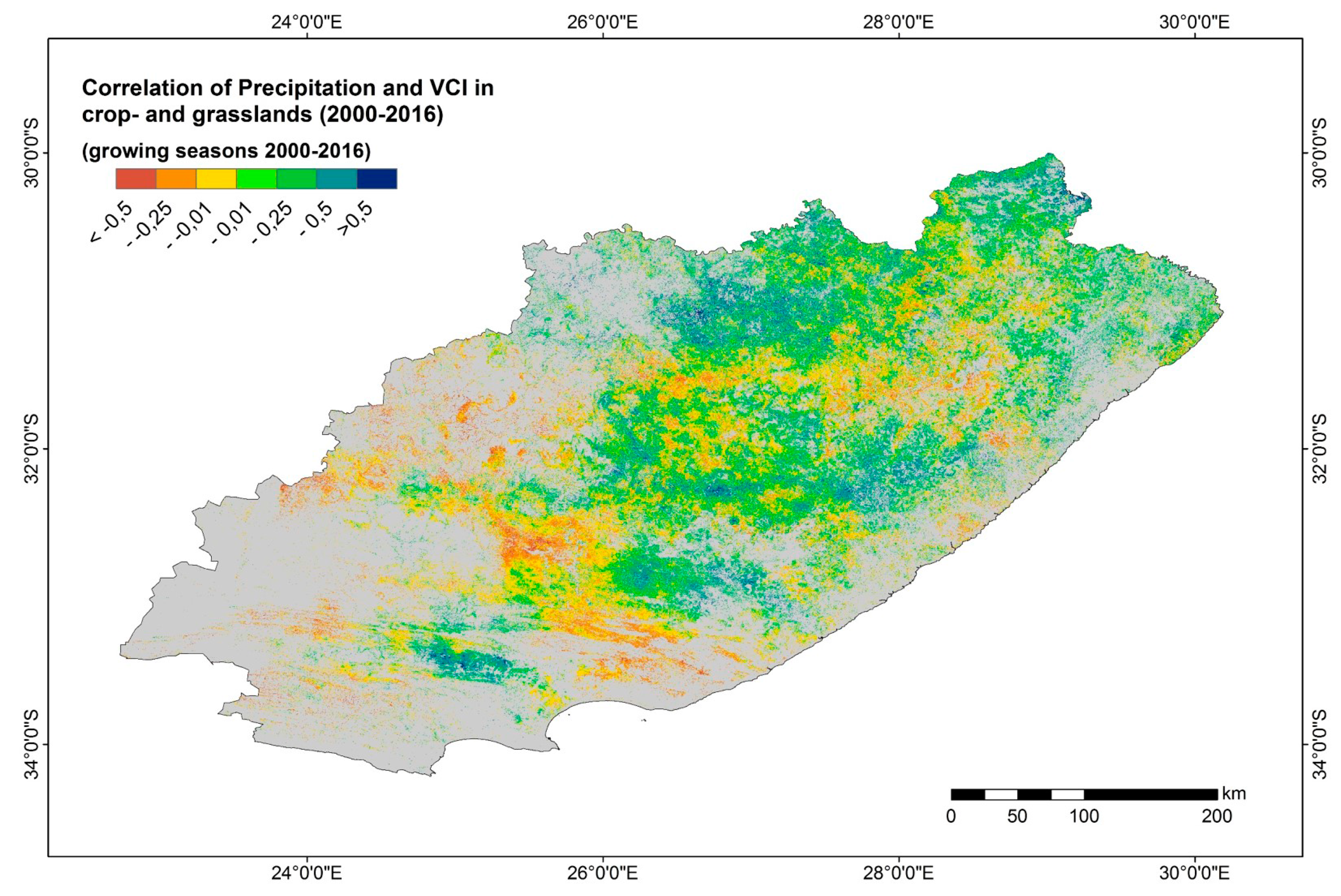
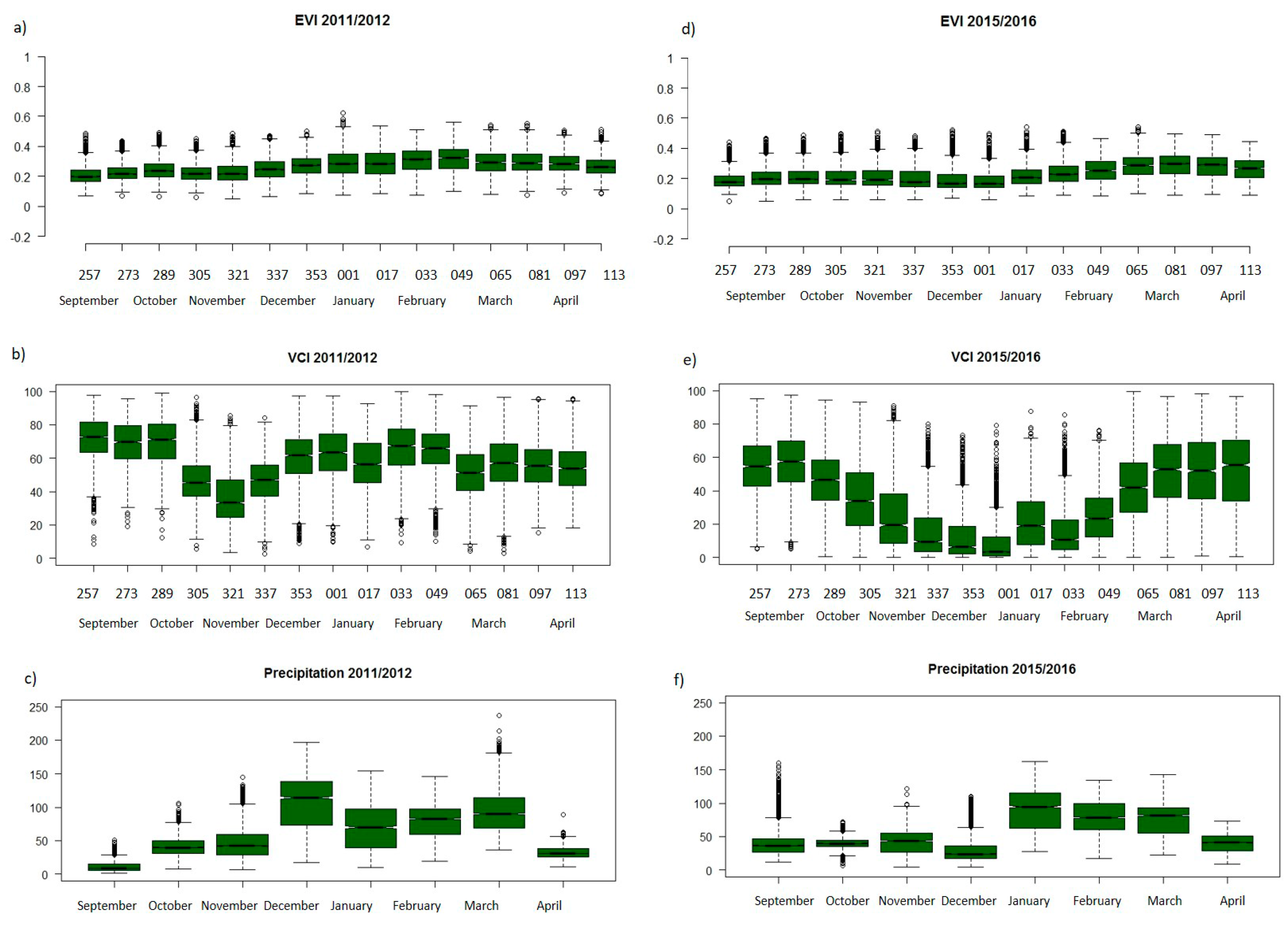
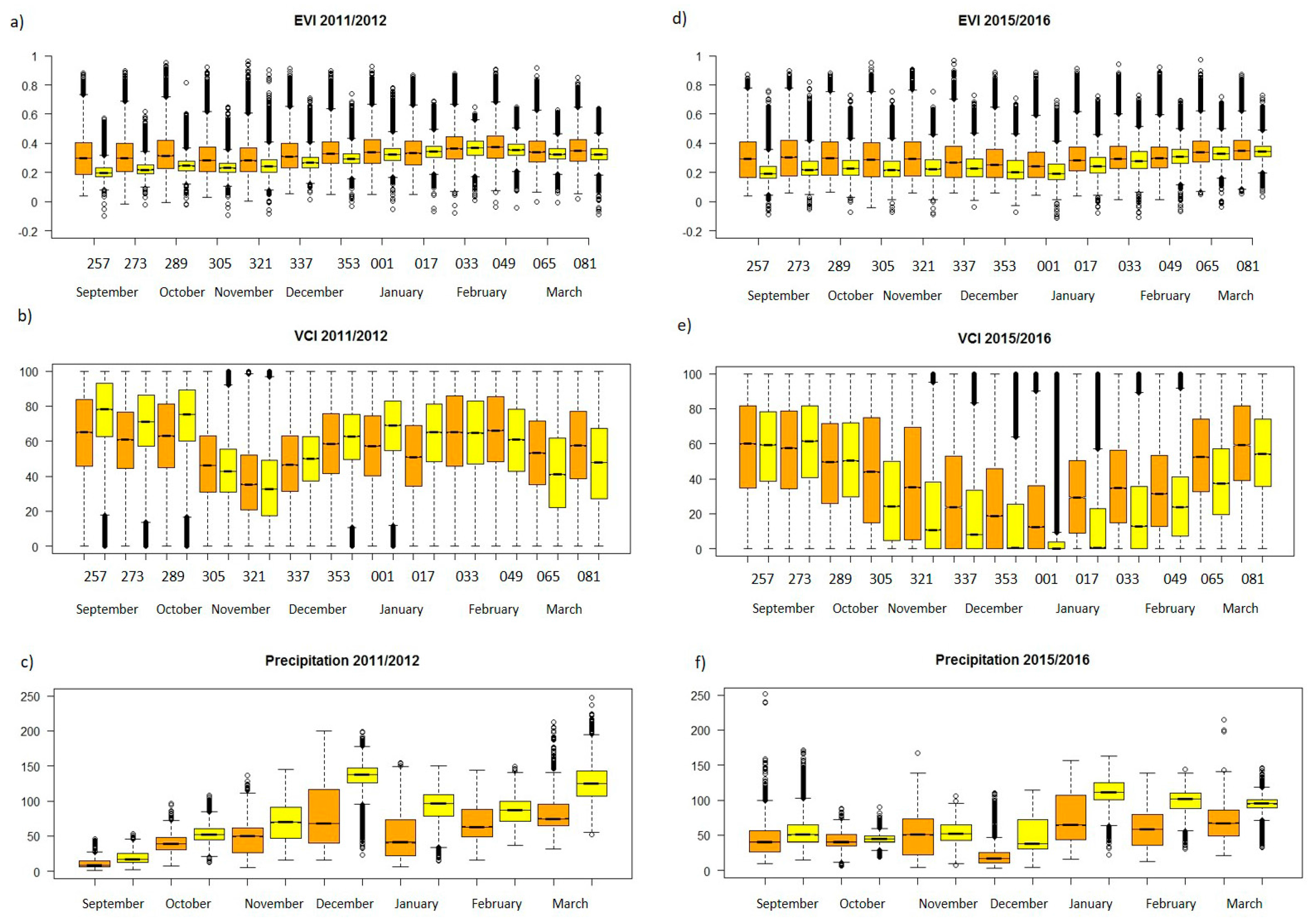
| Drought Hazard Severity Classes | VCI Values |
|---|---|
| No Drought | >40 |
| Mild Drought | 30–40 |
| Moderate Drought | 20–30 |
| Severe Drought | 10–20 |
| Extreme Drought | <10 |
© 2017 by the authors. Licensee MDPI, Basel, Switzerland. This article is an open access article distributed under the terms and conditions of the Creative Commons Attribution (CC BY) license (http://creativecommons.org/licenses/by/4.0/).
Share and Cite
Graw, V.; Ghazaryan, G.; Dall, K.; Delgado Gómez, A.; Abdel-Hamid, A.; Jordaan, A.; Piroska, R.; Post, J.; Szarzynski, J.; Walz, Y.; et al. Drought Dynamics and Vegetation Productivity in Different Land Management Systems of Eastern Cape, South Africa—A Remote Sensing Perspective. Sustainability 2017, 9, 1728. https://doi.org/10.3390/su9101728
Graw V, Ghazaryan G, Dall K, Delgado Gómez A, Abdel-Hamid A, Jordaan A, Piroska R, Post J, Szarzynski J, Walz Y, et al. Drought Dynamics and Vegetation Productivity in Different Land Management Systems of Eastern Cape, South Africa—A Remote Sensing Perspective. Sustainability. 2017; 9(10):1728. https://doi.org/10.3390/su9101728
Chicago/Turabian StyleGraw, Valerie, Gohar Ghazaryan, Karen Dall, Andoni Delgado Gómez, Ayman Abdel-Hamid, Andries Jordaan, Ruben Piroska, Joachim Post, Jörg Szarzynski, Yvonne Walz, and et al. 2017. "Drought Dynamics and Vegetation Productivity in Different Land Management Systems of Eastern Cape, South Africa—A Remote Sensing Perspective" Sustainability 9, no. 10: 1728. https://doi.org/10.3390/su9101728




